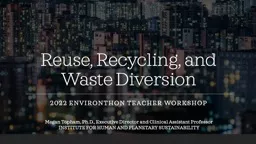

2022 ENVIRONTHON TEACHER WORKSHOP Megan Topham PhD Executive Director and Clinical Assistant Professor INSTITUTE FOR HUMAN AND PLANETARY SUSTAINABILITY Types of Waste Municipal Solid Waste Generation and disparities ID: 910933
Download Presentation The PPT/PDF document "Reuse, Recycling, and Waste Diversion" is the property of its rightful owner. Permission is granted to download and print the materials on this web site for personal, non-commercial use only, and to display it on your personal computer provided you do not modify the materials and that you retain all copyright notices contained in the materials. By downloading content from our website, you accept the terms of this agreement.
Slide1
Reuse, Recycling, and Waste Diversion
2022 ENVIRONTHON TEACHER WORKSHOP
Megan Topham, Ph.D., Executive Director and Clinical Assistant Professor
INSTITUTE FOR HUMAN AND PLANETARY SUSTAINABILITY
Slide2Types of Waste
Slide3Municipal Solid WasteGeneration and disparities
Slide4Slide5Slide6Slide7Impacts of WasteEnvironmental, Social, and Economic
Slide8Environmental Impacts – Waste (Mis)Management
Air emissions (fumes from the burning of waste and landfill gases)
Contamination of groundwater, aquifers, and surface water
Contamination of soil
Injuries to wildlifeNoise pollution
Ecosystem services in dangerMarine pollution
Slide9Economic Impacts – Waste (Mis)Management
Slide10Social Impacts – Waste (Mis)Management
Slide11Waste ManagementDisposal Hierarchy and distribution
Slide12Slide13Slide14Waste DiversionRecycling and repurposing
Slide15MetalsRecycling uses a considerable amount of energy, but less than if using virgin ore.Can be recycled over and over without altering its properties
Primary Types: Steel, Aluminum, Copper, Silver, Brass, and GoldUses:
Automobiles, Aircraft, Appliances, Industrial Containers, Ductwork, and PlumbingRecycled aluminum and steel are commonly reused as new food packaging
Slide16GlassUnlimited LifeCan be melted and recycled endlessly Recycling reduces the need for raw materials (i.e. sand, soda ash, limestone) and energy (e.g. running furnaces at lower temperatures)
Uses - new glass products with no loss in qualityGlass Bottles
Composite Glass CountertopsRecycled Glass Tiles and BacksplashesGlassphalt
BeadsConstruction Materials
Slide17PlasticsProcess:Collection, Sorting & Categorizing, Washing, Shredding, Melting, and Pelletizing
The actual particular processes vary based on plastic resin or type of plastic productTons of environmental, social, and economic benefitsRecycling can give people an incentive to buy and use more plastics
Can only be recycled a few timesUses:Bottles and Cups, Film and Sheeting, Traffic Cones, Packing Materials, Clothing, Trash Bags, Kitchenware, Countertops, and Carpeting, Animal Collars, Rugs and Mats, Shoes, Waste Bins, Building Materials, Outdoor Furniture, Surf Boards, Back Packs, etc.
Slide18Paper & Cardboard
Process for Paper:
Separated, Baled & Shipped to Mills, Cleaned, Dried & Rolled
Process for Cardboard:
Sorted & Shredded, Mixed w/ Water and Pulped, Filter, More Water, Rolled & Dried, Converted to New Cardboard
Paper products have a lifespan of 5-7 recycling processes.
Despite the negative impact, the pros continue to outweigh the cons
Uses:
Office paper, Tissues and Toilet Paper, Napkins and Paper Towels, Greeting Cards, Cardboard, Newspapers and Magazines, Coffee Filters, Diapers, Egg Cartons, Shoe Boxes, Napkins, Insulation, Fiber Board, Animal Bedding, Paper Bowls, Vases, and other Housewares, Wallpaper, lamps, Seating, etc.
Slide19ConcreteProcess:Crushed and impacted, and then screens come into play, which help separate the useful material from dirt and particles within the mix.
Additional processes and equipment, such as water flotation, separators, and magnets, may also be used to remove specific elements from the crushed concrete.Recycling one ton of cement can save 1,360 gallons water, 900 kg of CO2
.Uses:Permeable paving, Base for new asphalt paving, Bed foundation material, Aggregate for mixing new concrete, Mulch, Controlling streambank erosion, Retaining Walls, Privacy Screens, Ocean reef habitats, etc.
Slide20Tires/RubberProcess:Devulcanized - breaks down the bonds formed during the vulcanization process
Collect, Remove Steel Wires, Breakdown Whole Tires, Rubber Screening, Cleaning300 million tires are scrapped annually and most are put into landfillRubber is poisonous when just thrown away and has severe negative environmental impacts
About 250 million tires are recycled every year in the United States.Uses:Recycled Rubber Planters, Shoes, Mats, Mulch, Sports Turf, Gravel Substitute, Wastewater Treatment Filters, Tire-derived fuel (TDF) for controlled fires, Aggregate, etc.
Slide21Food & Agriculture
Slide22Waste ReductionStrategies, Policies, and change management
Slide23Procedures or Practices that People Follow
Slide24Processes or Equipment to be More Efficient
Slide25Products or Chemicals to Make Something Safer
Slide26Circular Economy
Slide27Net Zero CommitmentsNet Zero means consuming only as much energy as is produced, achieving a sustainable balance between water availability and demand, and eliminating solid waste sent to landfills.
Net Zero WaterNet Zero EnergyNet Zero Waste
Net Zero Plastic
Slide28Changing Behaviors through Policy
Slide29Questions/Comments?